
Official
Edgar Rice Burroughs Tribute and Weekly Webzine Site
Since
1996 ~ Over 15,000 Webpages in Archive
Volume
7010

THE RETURN OF TARZAN
Part IV: Chapters 19-26
Summary and Commentary
of All 26 Chapters
by John Martin

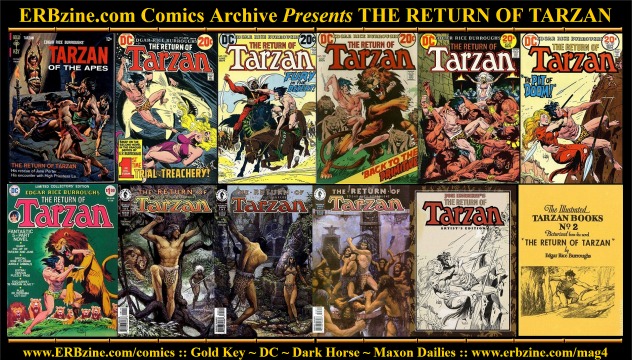
Click for full-size collage
CHAPTER XIX: THE CITY
OF GOLD
The second book of the Tarzan series is as important
as the first book in laying the foundation for all of the Tarzan stories
that would come later. After we have read "Apes", and discover how such
a remarkable person as Tarzan of the Apes could come to be, we then have
"Return," which (1) exposes him to the best and worst of civilization in
Paris, (2) sets up a series of confrontations with his worst enemies, Rokoff
and Paulvitch, (3) places the power of guns in his hands for the first
time in both the Sahara and the jungle, (4) establishes his leadership
role in the Waziri tribe, (5) introduces him to La and the gold of Opar,
and (6) seals his relationship with Jane.
Having heard from his predecessor of the city of gold,
Tarzan, newly proclaimed chief of the Waziri, wastes no time exercising
his authority, heading out to find the lost city with a complement of 50
warriors.
Meanwhile, ERB reminds us that -- 200 miles away upon
the ocean -- Jane, "thin and emaciated," is said to be in the coma that
precedes death.
Unaware of this, Tarzan has his eyes on the gold of the
lost city. He knows from his exposure to civilization that gold can bring
power, but he has not yet given any thought to what he would do with such
power in the middle of the jungle.
After a trek of several days, they come at last to the
valley where the city lies. As they approach, they see that it is a city
in ruins and yet, Tarzan "...discerned things moving..." and felt "...the
sensation of unseen eyes upon him."
As they camp outside the city overnight, the Waziri are
frightened out of their wits by "...a shrill scream from beyond the great
wall. It was very high at first, descending gradually until it ended in
a series of dismal moans."
The Waziri in "Return" are brave at times and frightened
at others. Once before, Tarzan had to threaten them in order to get them
to follow his orders. Now, as they balk about entering the city, Tarzan
threatens to go in by himself. Either out of loyalty to their new chief
and deliverer, or out of embarrassment for their own lack of boldness,
they follow.
As they make their way deep into the city, they often
sense "...dim, shadowy shapes..." moving about, "...many eyes upon them...",
and "...rustling in the shadows...."
"They are watching us, O king," whispered Busuli. "They
are waiting until they have led us into the innermost recesses of their
stronghold, and then they will fall upon us and tear us to pieces with
their teeth. That is the way with spirits."
Tarzan, at last, gives the Waziri permission to leave.
Some seem eager to do so but others consider staying with Tarzan. About
that time, another moaning scream decides the matter, and the Waziri flee
in fright.
Then we see Tarzan, standing alone in a Tarzan moment,
"...where they had left him, a grim smile upon his lips -- waiting for
the enemy he fully expected was about to pounce upon him."
But no enemy comes. Tarzan continues and finds a barred
door. Many warning shrieks tell him he should not enter that room which,
of course, only motivate him to do so. He batters down the door and goes
into a Stygian darkness. But that is where the enemy lies in wait. And
though the ape man is incredibly strong, he is soon overcome by the "...mere
weight of their numbers" and bound.
ERB gives us a detailed description of the men of the
city: "The thick, matted hair upon their heads grew low over their receding
brows, and hung about their shoulders and their backs. Their crooked legs
were short and heavy, their arms long and muscular. About their loins they
wore the skins of leopards and of lions, and great necklaces of the claws
of those same animals depended upon their breasts. Massive circlets of
virgin gold adorned their arms and legs. For weapons they carried heavy,
knotted bludgeons, and in the belts that confined their single garments
each had a long, wicked-looking knife."
They are described as white men with "...receding foreheads,
wicked little close-set eyes, and yellow fangs...."
They mumble to one another in a language unknown to the
ape-man. He is left, bound, alone in a ceiling court area for several hours.
Tarzan tests his bonds and determines he can probably break them when the
opportune time arrives.
As the sun climbs to a point where its rays start shooting
through an aperture in the ceiling, the court's upper parapets begin to
fill with the ugly men and then several with clubs come in and perform
a weird dance around the ape-man. Suddenly, they rush upon him with their
clubs but, at the same time, a "female figure" with a club of gold runs
in and begins beating them back.
- - - - -
SPECIAL PASSAGE:
"And on the far side of the valley lay what appeared
to be a mighty city, its great walls, its lofty spires, its turrets, minarets,
and domes showing red and yellow in the sunlight."
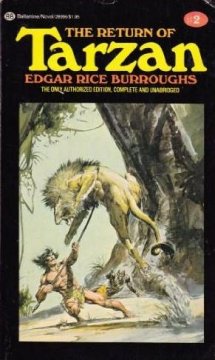
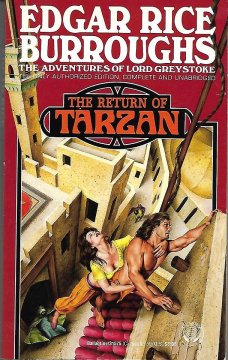
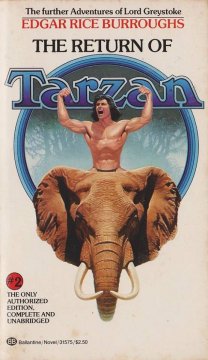
1. Neal Adams painted this cover art along with covers for several
more Ballantine Tarzans.
"The Return of Tarzan" was published in April 1975.
http://www.erbzine.com/mag36/3610.html
2. Barclay Shaw's covers for the first six Tarzan books were all
painted from the viewpoint of the artist on high,
looking down on the action, as in this cover for "The Return of
Tarzan"
of the ape man rescuing the dancing girl of Sidi Aissa, published
in November 1990.
3. Charles Ren painted covers for "Tarzan of the Apes" and "The
Return of Tarzan"
to tie in with the 1984 movie, "Greystoke: The Legend of Tarzan,
Lord of the Apes."
Ren's Greystoke showed a more Tarzanic physique than that of Christopher
Lambert
CHAPTER XX: LA
The young woman who briefly appeared
to be Tarzan's saviourette is anything but. By the ease with which she
beats back the gorilla-like Opar males, Tarzan realizes this is all part
of a time-worn ritual.
The girl does cut Tarzan's bonds, though, but only the
ones on his legs, so he can be led to another chamber. As they enter this
devlish arena, Tarzan sees an opening above from whence the noonday sun
is starting to beam through, and he correctly discerns he is among worshippers
of Old Sol.
As Tarzan stands by the reddish-brown-stained altar, a
procession of females -- shapely in contrast to the beastly men -- parade
in, each with two cups. Each of the males gets a cup from a woman and Tarzan
figures they will use them to catch and drink his blood.
At last another woman enters and from her ornaments and
bearing Tarzan figures her to be the high priestess of this unchurchly
gang. She is who we will come to know in this and other Tarzan adventures
as La, High Priestess of the Temple of the Sun.
La tries unsuccessfully to communicate with Tarzan in
several languages, to no avail. Then, La recites a long, boring prayer
and the beast-men put Tarzan on the altar.
There is trouble in the ranks, as one of the males starts
getting testy with another. La admonishes him and begins lowering her knife
toward Tarzan's chest in an excruciatingly slow manner.
What would have happened next is impossible to say. In
the previous chapter, Tarzan had tested his bonds and believed he could
break them if need be. However, he was sure taking his time about doing
it!!
Just then, however, the troublesome male goes mad and
begins clubbing and killing his fellow Oparians. Tarzan rolls off the altar
and breaks his bonds at last. The riot quickly empties the room but Tarzan
hears a scream from the High Priestess and rushes to the aid of she who
had been about to kill him.
Tarzan whips the Oparian male in a fair jungle fight and
then he and she discover they can communicate -- in the language of the
great apes. La formally introduces herself and there follows an exchange
in which she tells Tarzan the history of her people, how they started coming
to this place 10,000 years earlier to search for gold and how the ships
from the faraway mother country eventually stopped coming. An investigative
ship determined that the mother country had sank into the sea, thus spurring
the reader to conclude that it was ancient Atlantis. Cut off from their
lost countrymen, their African cities fell one by one to savage African
tribes until the last survivors took refuge in the mountain fortress we
now know as Opar.
They lived together with great apes (whom they call the
"first men"), thus learning their langauge. The men regressed over the
century to look more like apes, since the men who had originally been left
to guard Opar were of a lower order to start with. The women, meanwhile,
remained as fairly gorgeous babes, since they came from the pretty girls
who had been left behind as priestesses. Over centuries, though, La felt
the women would regress to look more like the men, and since some Oparians
had actually mated with apes (a crime for which the punishment was banishment)
she believed the human side of the Oparians would eventually disappear
and all would be like the apes.
Tarzan seeks La's aid in escaping from the maze of rooms
and hallway in the fortress. La says she wants to help, but is fearful
of being caught and killed, so she hides Tarzan in a room called the Chamber
of the Dead until she can figure a way to help him escape.
- - - - -
SPECIAL PASSAGE:
"You are a very wonderful man," she said. "You are
such a man as I have seen in my daydreams ever since I was a little girl.
You are such a man as I imagine the forbears of my people must have been
-- the great race of people who built this mighty city in the heart of
a savage world that they might wrest from the bowels of the earth the fabulous
wealth for which they had sacrificed their far-distant civilization."
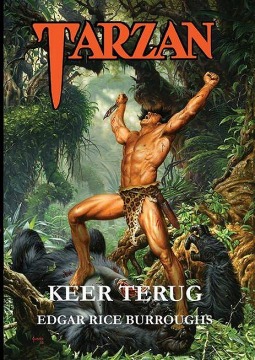 .
.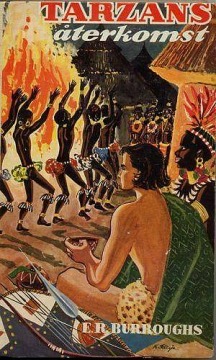
1. "Tarzan Keer Terug" is a recent Afrikaans edition of "The Return
of Tarzan,"
part of a reprint of the Tarzan series with covers by Joe Jusko.
Edgar Rice Burroughs, Inc., announced the new South African set,
by publisher Henoch Neethling, on Feb. 18, 2019.
See them all in ERBzine at:
www.erbzine.com/mag64/6475.html
2. "Tarzan aterkomst" is a Swedish edition of "The Return of Tarzan."
CHAPTER XXI: THE CASTAWAYS
Clayton, Jane and the insidious Rokoff,
alias "Monsier Thuran," cling to life in the tiny lifeboat somewhere off
the coast of Africa. Thuran, fortunately for Clayton, had passed out from
exhaustion before being able to carry out his plan of slitting Clayton's
throat and eating him.
Clayton, awakened by raindrops, crawls out from under
Thuran's unconscious body and makes his way to Jane, where he squeezes
out a rain-soaked rag to drop fresh water into "the swollen lips of the
hideous thing" that was his fiance.
Jane recovers slightly, and as she and Clayton discuss
the advisability of attempting to revive the murderous Thuran, the debate
is resolved by the sighting of land.
Clayton manages to pull the boat to shore and tie it fast
and makes his way into the jungle to pick fruit that he learned, through
his earlier experience in the jungle with Tarzan, was safe to eat.
At last all three are out of the boat, refreshed with
fruit, and sleeping off the ordeal.
By the end of the month, they had constructed a small
shelter in a tree, with an area partitioned off for Jane. Although Thuran
ought to show some gratitude, he continues in true character: selfishness,
boorishness, arrogance, cowardice, and lust. Clayton seldom leaves him
alone a moment with Jane.
When Jane happens to mention how lucky Thuran is that
Monsier Tarzan is not there to deal with him, Thuran realizes for the first
time that she knows his arch-enemy and he seizes the opportunity to slur
Tarzan's reputation. "You knew the pig?" he sneers, and it goes downhill
from there.
The reader is informed that just five miles north of their
location, through impenetrable jungle, is the tiny cabin in which Tarzan
of the Apes was born and, further north by a few miles are the other 18
survivors of the wreck of the Lady Alice. Among them, Professor Porter
is up to his usual absent-mindedness and, in the quest for scientific discovery,
makes an unsuccessful attempt to row a boat to New York to pick up a scientific
pamphlet. With great trouble, Mr. Samuel T. Philander manages to get him
back to the group.
After the second month of being castaways, a starving
lion nearly ends it all for Clayton and Jane, but the incident proves providential
to Jane in determining her personal future.
Jane spots the stalking lion behind Clayton and both know
they are too far from their shelter to make it to safety in time. Jane
is horrified when Clayton closes his eyes in fear and waits for the lion's
charge, instead of turning to battle it like a man with the stick he has
in his hands, even if such battle is futile.
Jane then drops to her knees and awaits the sure end by
praying.
But after long moments of nothing, she opens her eyes
to see that her prayer has been answered: The lion dead, transfixed by
a huge war spear. Clayton, relieved, attempts to kiss Jane but the whole
incident has served to remind her of how Tarzan, the man she now realizes
she truly loves, would have behaved, and she can no longer promise to marry
Clayton, and tells him so.
The chapter ends with a warning that another calamity
is nigh, but we will have to wait a chapter to find out what that calamity
is. The chapter also ends without any mention of who threw that spear that
killed the lion.
- - - - -
QUESTION:
Jane is free to love and marry whomever she wishes, but
was it really fair of her to call Clayton a coward to his face when she,
too, had closed her eyes and placidly awaited her fate from the lion?
- - - - -
SPECIAL PASSAGE:
"The thing that has just happened has again forced
to my memory the fact that the bravest man that ever lived honored me with
his love. Until it was too late I did not realize that I returned it, and
so I sent him away. He is dead now, and I shall never marry. I certainly
could not wed another less brave than he without harboring constantly a
feeling of contempt for the relative cowardice of my husband. Do you understand
me?"
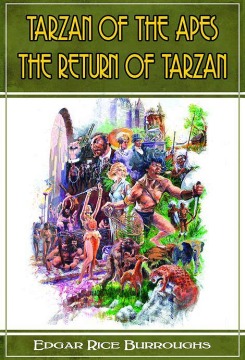 .
.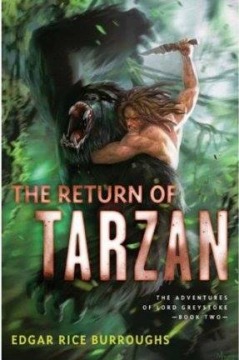
1. Homeworld Press (an imprint of Classic
Comics Press, Inc.) reprinted "Tarzan of the Apes" and
"The Return of Tarzan" in 2012 to commemorate the centennial of
the first appearance of Apes.
This 500-page hardbound has 488 pages, many with lavishly detailed
black and white illustrations created by Sal Amendola.
2. Daryl Mandryk is the artist for the Fall River Press edition
of "The Return of Tarzan," published in 2011.
See the large image art in ERBzine
0484
http://www.erbzine.com/mag36/tzdm.jpg
CHAPTER XXII: THE TREASURE
VAULTS OF OPAR
Tarzan waits in the Chamber of the Dead until at last
La returns, bearing food and drink. She credits him with being the first
one in history (but, as we know, not the last!) to escape from being sacrificed,
and 50 Opar men are out on a jungle trek even now, hoping to capture him.
The reason they haven't looked for him in the Chamber
of the Dead is because the spirits of the dead would sieze any living being
and sacrifice them...except La, of course, because the dead won't harm
the high priestess, and Tarzan, of course, because he doesn't believe in
all this and, in fact, neither does La, she reveals.
In the darkness of nighttime Opar, La leads Tarzan to
another chamber and locks him in, telling him he will be safe until morning.
In the darkness, Tarzan discovers the presence of a draft
of air and tests the part of the wall from whence it comes, discovering
that the bricks are loose. He removes as many as necessary to explore the
passage beyond, and continues until he comes to an abyss. Moonlight from
an opening above reveals the abyss is a deep well, 15 feet across. Beyond
it, the passage continues, and so the agile ape man leaps the abyss and
continues on, until he passes a creaky door and encounters a stash of ingots.
They were heavy enough to be gold but the ape-man couldn't tell for sure
in the dark, so he brought one along as he continued to negotiate various
passageways and stairs until at last he comes out into the starry sky to
see Opar a mile away. And, the ingot he holds in his hand is virgin gold!
Tarzan soon locates a wisp of campfire smoke and investigates.
It is his 50 Waziri warriors, inside a boma. He calls: "Arise, my children,
and greet thy king!" and drops from a tree into their midst.
The Waziri report that, ashamed of their earlier cowardice,
they were on their way back to Opar to either rescue Tarzan or avenge his
death. They report having seen the 50 men of Opar, but the Oparian men
had not seen the woodcraft-skilled Waziri.
Tarzan leads the Waziri back to the secret entrance to
Opar, and each man is laden with two forty-pound ingots. He leads the Waziri
near to a spot known to him as a Great Ape Dum-Dum site and, after the
50 leave, he carries the ingots, one at a time, to the Dum-Dum amphitheatre
and buries them. Conveniently, he had stashed there the same shovel he
had used to bury, for safekeeping, the chest of Professor Porter back in
"Tarzan of the Apes."
The next morning, Tarzan made his way to the cabin of
his long-dead parents and then traveled south to hunt. Soon, he caught
the scent of man and Numa, and hastened his pace. He came upon the scene
of Jane and Clayton, both with eyes closed, awaiting death from the tawny
yet scrawny lion. Not recognizing either but motivated to help, Tarzan
hefted his spear and brought the beast down.
When Jane opened her eyes and raised her head, Tarzan
recognized her but, before he could make himself known, he saw Clayton
take her in his arms to kiss her. The beast in Tarzan awoke, his scar burned
scarlet, and he drew a poisoned arrow in his bow, aimed at his rival's
back.
Then, the fury passed. Tarzan "with bowed head, turned
sadly into the jungle toward the village of the Waziri."
- - - - -
LESSONS IN GREEK:
This chapter contains a few lessons in Greek mythology.
-- "When Tarzan stood it was dark as Erebus." Erebus,
meaning "deep blackness, darkness or shadow," was the son of Chaos and
represented the personification of darkness and shadow, which filled in
all the corners and crannies of the world.
-- "He had advanced some hundred feet when he came to
a flight of steps leading downward into Stygian gloom." Of or pertaining
to the river Styx, the principal river of the underworld in Greek mythology;
hence, hellish; infernal. Dark and dismal.
-- "Finally the feat was accomplished by dint of herculean
efforts upon the part of the ape-man." Requiring the great strength of
a Hercules; very hard to perform.
- - - - -
SPECIAL PASSAGE:
"Opar," he mused, "Opar, the enchanted city of a dead
and forgotten past. The city of the beauties and the beasts. City of horrors
and death; but -- city of fabulous riches."
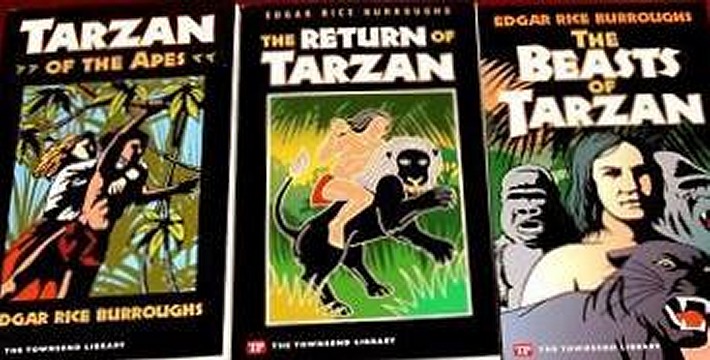
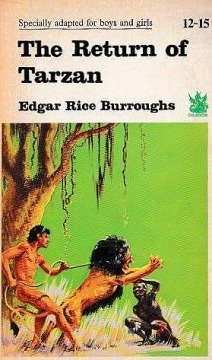
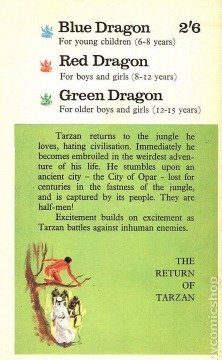
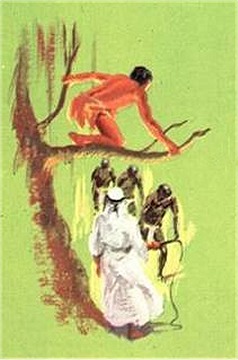
1. Townsend Press published three Tarzan books in its "Townsend
Library" series, "Apes," "Return" and "Beasts."
The books have been edied for younger readers
2. The Green Dragon edition of "The Return of Tarzan," edited with
young people ages 12-15 in mind,
was published in 1967 along with six other Tarzan titles in seven
other books (Jewels of Opar was split into two volumes.)
Artist was Edward Mortelmans.
3. The back side of the Green Dragon edition of "The Return of Tarzan"
features additional art by Ed Mortelmans.
CHAPTER XXIII: THE FIFTY
FRIGHTFUL MEN
Jane and Clayton wonder who threw the
spear that saved them from the lion. Clayton calls out a "thank you" but
there is no response, and Jane comments that the "mysterious jungle...renders
even the manifestation of friendship terrifying."
Jane feels a bit sorry for the way she spoke to Clayton,
and assures him he is a brave man, although she still meant what she said
as far as not wanting to enter into marriage with him.
Clayton, armed with the spear from the lion's body, goes
in search of food while Jane sits at the foot of the shelter and Thuran,
delirious with fever, moans above.
The jungle fronds part and the wild, matted-hair faces
of some of the Oparian men peer out. Suddenly, they rush forward and grab
Jane, clapping a hand over her mouth, and drag her off into the jungle.
For a march of days she is cuffed, kicked and otherwise mistreated until
her clothes rip, exposing her skin to further torture from thorns and brambles.
At last, she can move no more and the Opar men have to carry her on the
last two days of their trek to Opar.
For a brief moment in Opar, Jane has some hope when she
sees the more civilized-looking women of Opar, but that hope is soon dashed,
as these women seem to be of no help to her.
Jane is tossed into a dark cell and fed and watered daily,
the Oparians, unknown to her, getting her in shape for her date on the
altar of the Temple of the Sun.
Tarzan, meanwhile, decides he has had enough of the company
of other men, even the Waziri, and roams on his own, ending up at the Dum-Dum
amphitheatre, where he sleeps for a few nights until he detects the approach
of a band of Mangani.
When they arrive, Tarzan discovers it is the same tribe
he grew up with and, when he introduces himself, some actually remember
him from two years before, although the memory of apes is not the best.
They accept Tarzan among them again except for one young bull, who tries
to establish his place in the tribal pecking order above the ape-man. Tarzan
beats the young bull in combat without killing him, further establishing
his credentials as an ape. When the apes realize Tarzan is able to help
them find better food sources than they had before, they soon accept him
as their new leader.
Tarzan was, at first, content to be an ape again, but
soon he began to feel guilt about Jane, with only Clayton to protect her,
and determined to go back and watch over her. Before he did, however, a
young bull reported having seen the 50 frightful men with a female captive.
Tarzan quizzed the bull and, determining it was most likely Jane they had
in their power, he left immediately once again for the lost city.
- - - - -
QUESTION:
Clayton pulled the spear from the body of the lion to
go hunting. Why didn't they just start in eating the freshly killed lion?
They'd already eaten worse!
- - - - -
SPECIAL PASSAGE:
"He had seen the woman he craved -- his woman -- his
mate -- in the arms of another. There had been but one course open to him,
according to the fierce jungle code that guided him in this other existence;
but just before it had become too late the softer sentiments of his inherent
chivalry had risen above the flaming fires of his passion and saved him.
A thousand times he gave thanks that they had triumphed before his fingers
had released that polished arrow."
 .
.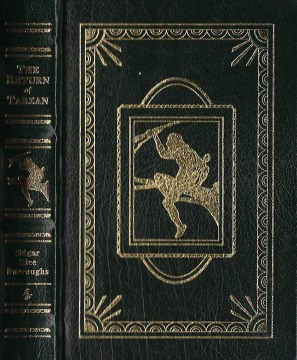
1. This edition of "Tarzan of the Apes" and "The Return of Tarzan"
by Word Cloud Classics
is available in hardback, softcover, kindle and maybe one or two
other ways.
2. This Easton Press edition of "The Return of Tarzan" is part of
a set that reprints the first six Tarzan books.
CHAPTER XXIV: HOW TARZAN
CAME AGAIN TO OPAR
Just about everybody shows up in this
chapter. First, it's Clayton and Thuran (aka Rokoff). Clayton, discovering
Jane is missing, conducts a brief search and then begins tending to the
recovering Thuran. Although he had earlier wished that Thuran would simply
die, the gentleman in him motivated him to bring food and water to the
suffering scoundrel. However, when the situation was reversed, and Clayton
became sick while Thuran got better, Thuran helped Clayton not at all,
and even mocked the Englishman's helpless condition.
Eventually, Thuran recovered sufficiently to attempt a
trek north, and left Clayton to die.
Meanwhile, up north, in Lord Tennington's camp, Professor
Porter provides some comic relief. Then, Tennington, in a conversation
with Hazel Strong, inadvertently discovers that Hazel and Thuran are not
"an item," as Thuran had led him to believe. Tennington then, rather awkwardly,
manages to convey to Hazel that he has feelings for her, and about that
time a bedraggled Thuran himself shows up, with his own version of the
tragedy that befell the others.
Jane, meanwhile, gains strength in the Opar dungeon and,
at last, the women of Opar come to dress her in finery and lead her out.
Jane thinks they are treating her kindly because of their religion, and
she is partially right. But when she sees the dark-brown stained altar,
she realizes what kind of religion they have, and gives up all hope as
she is bound, placed on the altar, and the knife begins to descend.
Then, the scene shifts to Tarzan, racing through the jungle
for a day and a night, racing "along the middle terrace high above the
tangled obstacles that impede progress upon the ground."
Tarzan enters the city the same way he escaped from it,
retracing his way through the dark tunnels and leaping over the chasmic
well and then tearing out the loose bricks from the wall and into the chamber
beyond, only to find the door securely locked. Sounds from beyond convince
him that the Oparian sacrificial ceremony is under way, and that he may
-- after all his efforts -- simply be a moment too late to save Jane.
Retrace his steps he must, but as he goes back it occurs
to him that he might tie a large stone to his rope and toss it through
the moonlit opening over the well, and perhaps then scale the rope to get
out of the tunnel and gain quicker access to the Temple of the Sun.
He does so and clings on the rope above the chasm. But
the rope begins to slip.
- - - - -
ERB WORD:
"Like a cat he scaled the precipitous sides of the
frowning granite kopje." This word, which has sent many a reader scurrying
to dictionaries, appears in italics in the text. It is a South African
noun that means "a small hill rising up from the African veldt."
- - - - -
SPECIAL PASSAGE:
"Until dark the Englishman searched the nearby jungle
for a trace of the missing one or a sign of the trail of her abductor.
But though the spoor left by the fifty frightful men, unversed in woodcraft
as they were, would have been as plain to the densest denizen of the jungle
as a city street to the Englishman, yet he crossed and recrossed it twenty
times without observing the slightest indication that many men had passed
that way but a few short hours since."
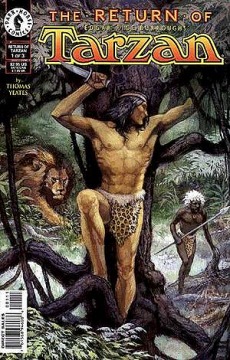
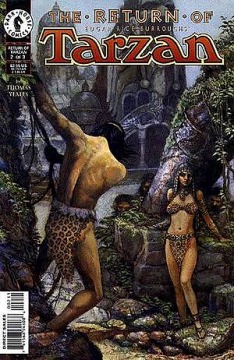
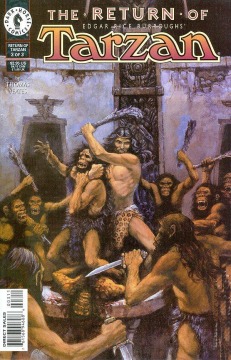
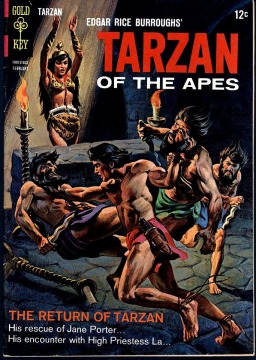
1. First of a three-part Dark Horse adaptation of "The Return of
Tarzan."
The cover was by John Totleben but the writing and art inside were
the work of Thomas Yeates.
Part 1 is the story of Tarzan's unplanned return to his old haunts,
through his meeting with the Waziri,
culminating in the victory over the slave and ivory raiders. The
back cover features the N.C. Wyeth painting of "Return."
2. Second of a three-part Dark Horse adaptation of "The Return of
Tarzan,"
with cover by John Totleben and story and art inside by Thomas Yeates.
Part 2 brings Jane and the other shipwreck survivors into Africa
and follows Tarzan to his first visit to Opar
and introduction to high priestess La.
This installment winds up when Tarzan saves Jane and Clayton by
spearing the lion
that was about to attack them. Back cover is an advertisement for
another Dark Horse title, "Elric."
3. Third part of a three-part adaptation of "The Return of Tarzan,"
with cover by John Totleben and story and art by Thomas Yeates.
In Part 3, the story takes Tarzan and the Waziri from the treasure
vaults of Opar
to his rescue of Jane from the city to their marriage and departure
from Africa.
Back cover is a reproduction of the two covers of "New Story" featuring
Wyeth paintings for the first appearance of "Return."
4. Gold Key did a comic book version of "The Return of Tarzan,"
Tarzan issue 156 in February of 1966.
Though it described Jane as half-dead when she was in the lifeboat,
she was as chipper and lipsticked as ever when she got out.
Morris Gollub painted the cover and Russ Manning did the story art
inside. Gaylord DuBois provided the script.
Read the whole comic in ERBzine 2556
www.erbzine.com/mag25/2556.html
CHAPTER XXV: THROUGH THE
PRIMEVAL
The last chapter ended with Tarzan hanging by a slipping
rope over an abysmal well. But the reader needed to look only at the next
page to find out the ape-man was not in trouble for long. The rope soon
lodged firmly and Tarzan hoisted himself up and then raced across Opar
to rescue his love, Jane.
Bursting into the ceremonial room where La is slowly lowering
the sacrificial knife toward the unconscious Jane, Tarzan goes mad with
rage, grabbing a cudgel and flailing about among the Oparians with much
more unbridled passion and power than even the most insane Oparian male.
In the brief seconds before Tarzan makes his way to La,
the reader is treated to the rapid-fire private thoughts of the High Priestess.
She
had never intended to help Tarzan escape from Opar, but had concocted a
cockeyed plan that she thought would actually persuade the ape-man to stay
there with her as her kept man!
If Tarzan would have known that, he probably would have
been even angrier. But, as it was, he was plenty angry at the sight of
La about to end Jane's life.
"One side, La," he ordered. "You saved me once, and
so I would not harm you; but do not interfere or attempt to follow, or
I shall have to kill you also."
And we can believe that Tarzan would have done just that.
La, still ignorant of the identity of her intended victim,
asks Tarzan who she is. And, in words that bring a satisfied sigh to readers
who have worried through two Tarzan books, the ape-man at last settles
the matter with the simple declaration: "She is mine!"
Then, Tarzan scoops Jane up in his arms and begins his
mad dash escape, soon followed by the howling Oparians who have recovered
from the shock of Tarzan's mad rampage. Fleet of foot is Tarzan, though,
even with his beautiful burden, and before long the Oparians give up the
chase and Tarzan and Jane are safe in the forest.
It takes a little ministration from Tarzan to awaken Jane,
and even then she at first believes she is dreaming. For one thing, she
thought Tarzan was dead from his unplanned ocean liner plunge into the
ocean, yet here he is alive!
Romantic words are exchanged as Jane calls the ape-man
"My Tarzan" and "my man." Soon, they bring each other up to date on everything,
even including Tarzan's missteps with the beautiful Olga de Coude.
They make their way back to the coast, picking up a detachment
of Waziri along the way, and end up at the beach shelter in time to briefly
revive the dying Clayton. This encounter gives Clayton the opportunity
to produce the telegram Tarzan dropped on the floor of the Wisconsin railway
station, in which D'Arnot informed the ape-man that he was the rightful
heir to the title and fortune of Lord Greystoke. The visit with Clayton
also gives them an opportunity to learn of the most recent perfidy of Monsieur
Thuran.
- - - - -
QUESTION:
Why did William Clayton hang onto that telegram and bring
it with him on this trip? Even after all he had been through, his clothing
in shreds and replaced by crudely fashioned garments of small animal skins,
he still had that piece of paper. He didn't even use it to get a campfire
started!
- - - - -
SPECIAL PASSAGE:
“La's hand was descending slowly toward the bosom
of the frail, quiet figure that lay stretched upon the hard stone. Tarzan
gave a gasp that was almost a sob as he recognized the features of the
girl he loved. And then the scar upon his forehead turned to a flaming
band of scarlet, a red mist floated before his eyes, and, with the awful
roadR of the bull ape gone mad, he sprang like a huge lion into the midst
of the votaries.”
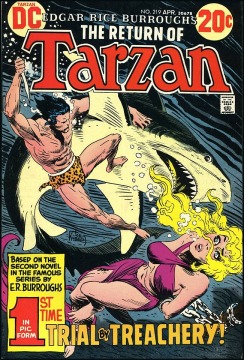
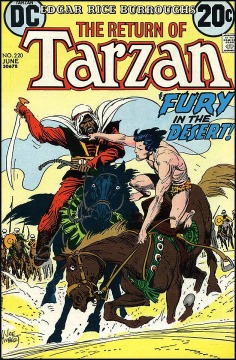
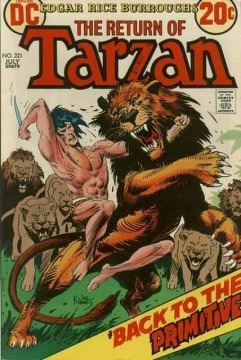
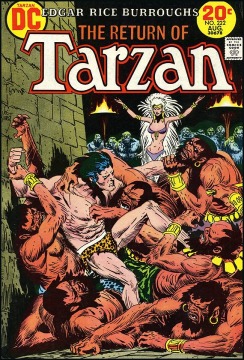
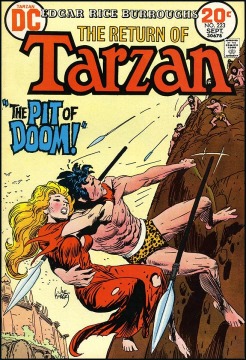
1. Joe Kubert spread the story and art of “The Return of Tarzan”
over five issues of DC comics.
The first installment, No. 219, begins with Tarzan’s encounter with
the Paris Apaches
and tells the story of his first meetings with Rokoff and the De
Coudes in flashbacks.
If you’re looking at the cover and wondering when Tarzan rescue
a blonde from a shark in “Return,” you’re not alone.
Neither readers of ERB’s original novel or this comic book have
a clue. Great action cover, though!
http://www.erbzine.com/mag57/5719.html
2. Part 2 of Joe Kubert’s five-issue DC treatment of “The Return
of Tarzan”
came in issue 220, with the ape man’s adventures in the Sahara.
http://www.erbzine.com/mag57/5720.html
3. Part 3 of Joe Kubert’s five-issue DC version of “The Return of
Tarzan,” issue 221,
takes Tarzan from the end of his adventure in the Sahara to his
chiefdom of the Waziri.
http://www.erbzine.com/mag57/5721.html
4. Part 4 of Joe Kubert’s five-issue DC adaptation of “The Return
of Tarzan,” issue 222,
tells the story of Tarzan’s first visit to Opar, his narrow escape
from becoming a sacrifice,
and finally his subsequent discovery that Jane has been captured
and is also about to be sacrificed to the flaming god.
http://www.erbzine.com/mag57/5722.html
5. Part 5 of Joe Kubert’s five-issue DC re-telling of “The Return
of Tarzan,” issue 223,
relates Tarzan’s rescue of Jane from Opar, their reunion with the
other shipwreck survivors, and the disposition of Rokoff.
http://www.erbzine.com/mag57/5723.html
CHAPTER XXVI: THE PASSING
OF THE APE-MAN
Tarzan, Jane and the Waziri make their
way north with the body of Clayton, to bury it beside the ape-man's dead
parents next to his little cabin.
On the way, they run into Professor Porter, who has wandered
off again, and it is a joyous reunion between father and daughter. They
learn that all of the other survivors of the Lady Alice shipwreck are now
at Tarzan's old cabin, and when they get there they find another surprise
-- Tarzan's friend Lt. Paul D'Arnot has anchored in the harbor with a French
ship.
Tarzan is most anxious to renew his acquaintance with
the despicable Rokoff, who no longer needs to be referred to as Monsieur
Thuran. Rokoff and Lord Tennington were out hunting when Tarzan and Jane
reached the cabin, and Jane comments on how surprised he will be to see
the ape-man again, since Jane now knows it was Rokoff's hands that pushed
the off-guard Tarzan from the ocean liner.
"His surprise will be short-lived," said Tarzan.
But Jane admonished: "In the heart of the jungle, dear,
with no other form of right or justice to appeal to other than your own
mighty muscles, you would be warranted in executing upon this man the sentence
he deserves; but with the strong arm of a civilized government at your
disposal it would be murder to kill him now...."
Tarzan sees the wisdom of her argument, but Rokoff has
no such sense of civility or even common sense. When he returns and sees
Tarzan, a "Sapristi" escapes from his lips and he raises his rifle to nail
the ape-man, despite the presence of a couple dozen witnesses.
Tennington pushes the rifle aside as the shot is fired
and Rokoff is soon clapped in irons aboard the cruiser. But first, Tarzan
pats Rokoff down and finds on him the government papers that he had stolen
much earlier. Professor Porter, who carries the title of ordained minister,
among his other credentials, conducts the burial service for Clayton.
The next day, Tarzan and the Waziri leave to fetch Tarzan's
"belongings," which turn out to be his 50 ingots of gold.
Then, it is suggested that Professor Porter perform one
more ceremony before they depart, the wedding of Tarzan and Jane. Lord
Tennington thinks it a splendid idea if he and Hazel Strong also exchange
vows to make it a double wedding.
Aboard the ship, Tarzan and Jane watch the receding coast
line. And this might have been the end of the Tarzan saga. Yet, there was
a hint it might continue when Tarzan said to Jane: "I should hate to think
that I am looking upon the jungle for the last time, dear...."
- - - - -
OBSERVATION:
Just as Clayton carried the Greystoke telegram with him
across three continents and held onto it when all his other possessions
were rotted rags, so Rokoff held onto his stolen papers with tenacity.
This ability was probably the only thing the two men had in common.
- - - - -
SPECIAL PASSAGE:
"The next day they sailed, and as the cruiser steamed
slowly out to sea a tall man, immaculate in white flannel, and a graceful
girl leaned against the rail to watch the receding shore line upon which
danced twenty naked, black warriors of the Waziri, waving their war spears
above their savage heads, and shouting farewells to their departing king."
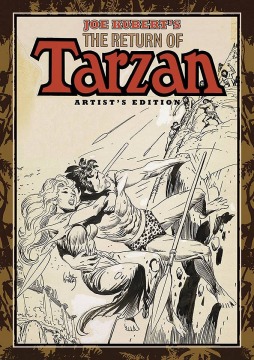 .
.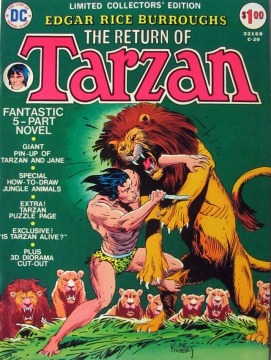
1. The "Artist's Edition" of Joe Kubert's art for "The Return of
Tarzan" and other stories was published by IDW in 2015.
This volume has issues #214, 217 – 223 -- three stand-alone adventures,
as well as "Return."
Each story page was scanned from Kubert’s original art, and all
but two of his covers.
The original price for this volume was $125. IDW's website says
"While appearing to be in black and white,
each page has been scanned in COLOR to mimic as closely as possible
the experience of viewing the actual original art—
for example, you are able to clearly see paste-overs, blue pencils
in the art, editorial notes, art corrections.
Each page is printed the same size as drawn, and the paper selected
is as close as possible to the original art board."
2. "The Return of Tarzan" got five covers in the regular DC run
with Joe Kubert art,
but a sixth one was provided for the giant-size edition with stiffer
cardboard covers and reprints of all five stories inside.
A similar edition was done for the preceding collection, "Tarzan
of the Apes."
There's no official count on how many fans took scissors to cut
out and assemble the special diorama.

ERBzine References:
The Return of Tarzan in C.H.A.S.E.R. Bibliography
www.erbzine.com/mag4/0484.html
Read the Entire Text of The Return of Tarzan
www.erbzine.com/craft/t2rt.html
The Pulp Magazine Covers for The Return of Tarzan
Featured in
The ERBzine.com Pulp Bibliography
www.erbzine.com/mag2/0221.html
Bill Hillman Returns to Tarzan 1955
www.erbzine.com/mag62/6263.html
Return of Tarzan: 60 Strips from 1929 by Rex Maxon
~ Reprinted in ERBzine
www.erbzine.com/mag20/2011.html
The Return of Tarzan in the Gold Key Comic in ERBzine
2556
www.erbzine.com/mag25/2556.html
The Return of Tarzan in DC Comics: 5 Issues starting
at ERBzine 5719
http://www.erbzine.com/mag57/5719.html

THE RETURN OF TARZAN
Summary and Comments by John
Martin





BILL
HILLMAN
Visit
our thousands of other sites at:
BILL
AND SUE-ON HILLMAN ECLECTIC STUDIO
All
ERB Images© and Tarzan® are Copyright ERB, Inc.- All Rights Reserved.
All
Original Work © 1996-2019 by Bill Hillman and/or Contributing Authors/Owners
No
part of this web site may be reproduced without permission from the respective
owners.





 .
.






 .
.









 .
.
